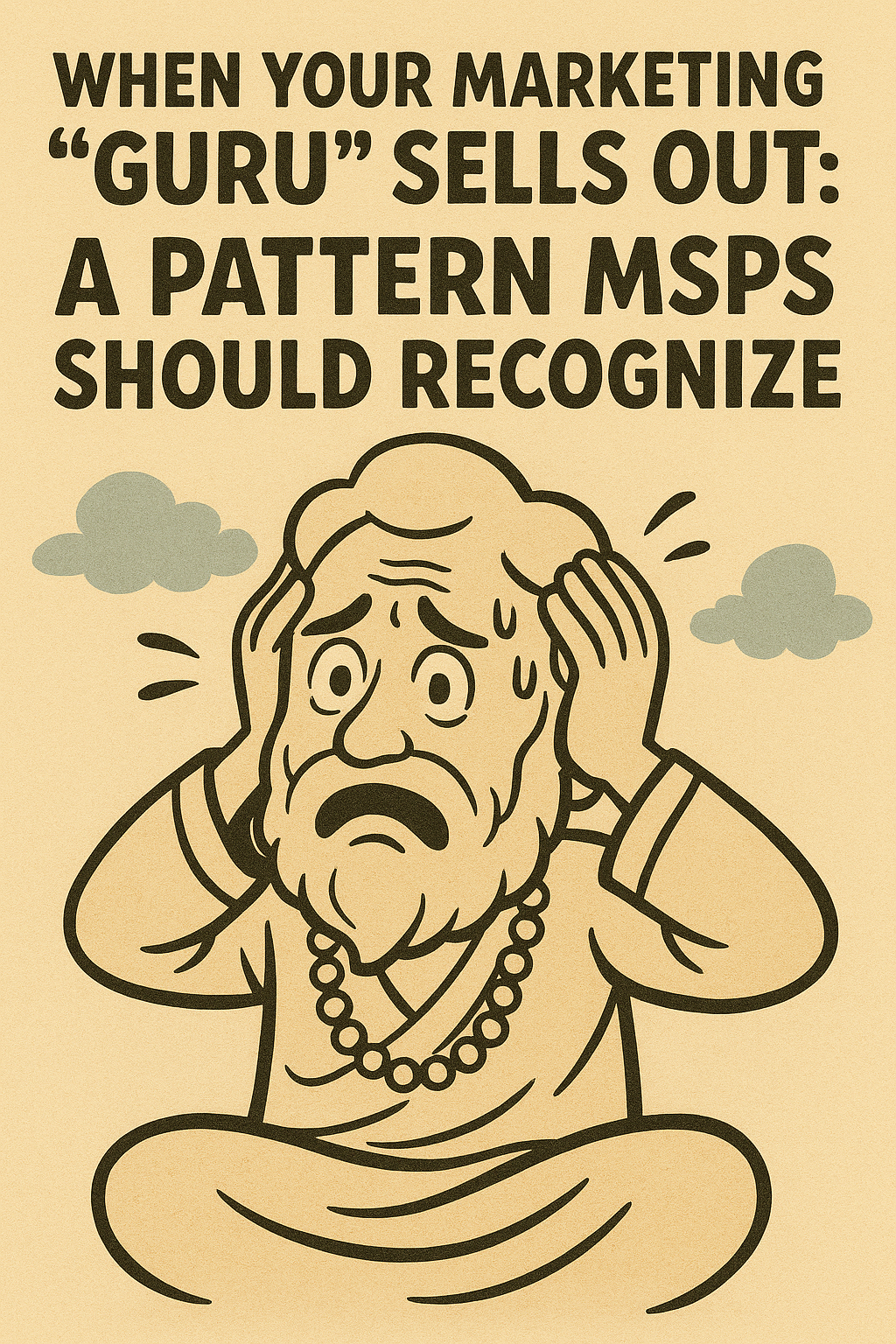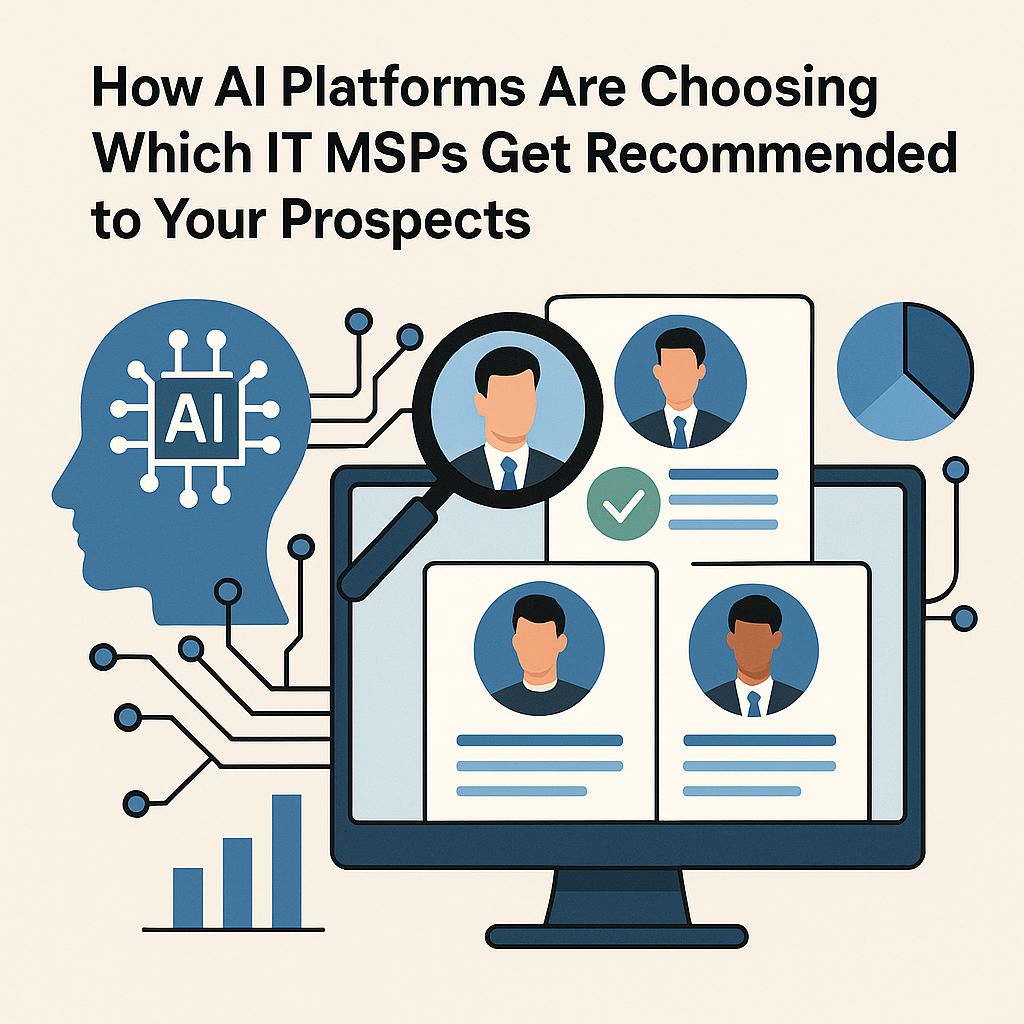
When Your Marketing “Guru” Sells Out: A Pattern MSPs Should Recognize
The Bottom Line: When trusted marketing mentors get acquired by major vendors, the independence that made their advice valuable disappears. This recent high profile acquisition follows a familiar pattern that smart MSPs can learn to spot and avoid.
A Personal Perspective From the Inside
Let me be transparent: I learned valuable lessons from this particular guru during my MSP years. I was part of their inner circle, following their teachings for a decade. Much of my early success I attribute to their original principles back when independence was their core value.
But I also witnessed something else: the gradual shift from independence to vendor alignment. The guru likely received a nine figure payday for this transition, but what did their followers get in return?
The Pattern: How Independence Dies
The Timeline We’ve Seen Before
Early Years: Major vendor starts sponsoring events. Seems innocent, just another sponsor.
The Middle Phase: Vendor becomes permanent fixture. Guru starts highlighting specific tools. Inner circle discussions subtly shift toward vendor compatible solutions.
The Revelation Phase: Shared corporate addresses discovered through public records. Members aren’t informed about these arrangements.
The “Surprise”: Acquisition announced as beneficial partnership.
According to industry analysis, MSPs are increasingly drawn to consolidating services under one vendor for streamlined operations, but the risks of vendor lock in, dependency, and loss of flexibility have some experts urging caution. This pattern repeats when marketing consultants develop too close relationships with software vendors, ultimately compromising the independence that initially made them valuable.
What MSPs Are Really Thinking
I’ve spoken with about 30 MSPs since this acquisition. The responses follow a pattern:
- Feeling betrayed after years of paying for “independent” advice
- Questioning whether previous tool recommendations were truly unbiased
- Concerns about premium memberships becoming vendor sales funnels
- Wondering how long this transition was actually planned
The consensus is clear: this feels less like a partnership and more like a carefully orchestrated exit strategy.
The “Advisory Role” Reality
The acquired guru announced they’re stepping into an “advisory role” focused on members. After securing what was likely a nine-figure payday, the motivation to maintain day to day involvement naturally changes.
Here’s what typically happens:
- Former mentor maintains income stream
- Acquiring company gets brand credibility and customer list
- Members lose direct access to actual independent thinking
- Marketing strategy becomes part of vendor ecosystem
The “advisory” structure allows everyone to claim continuity while the fundamental relationship has changed completely.
Understanding Vendor Consolidation Impact
74% of respondents said they prefer to use fewer vendors to meet their technology needs, up from 64% in 2022. This trend toward consolidation affects every aspect of the MSP ecosystem, including marketing consultancy.
When your marketing consultant gets acquired, you’re experiencing this consolidation pressure firsthand. The question becomes whether this consolidation serves your interests or the acquiring company’s revenue goals.
The Resource Allocation Reality
While MSPs deal with operational challenges, acquiring companies often prioritize different investments:
- Marketing expenditures including arena naming rights and major sponsorships
- Acquisition sprees to eliminate competition and build ecosystems
- Executive compensation packages and shareholder returns
- Maximize billing and revenue
The disconnect between marketing spend and customer experience improvement raises questions about priorities and focus areas.
The Independence Challenge in Marketing
Marketing consultants face increasing pressure to align with vendor ecosystems. There are more marketing tools, gurus, tricks, peer groups, and workshops vying for your money than stars in the sky. Be cautious about where you invest your time and money because gimmicks rarely pay off.
This advice becomes particularly relevant when consultants themselves become part of vendor ecosystems through acquisitions.
Red Flags Every MSP Should Watch For
🚩 Corporate Address Sharing
Check public records for your consultants and their business registrations.
🚩 Sponsor Progression
Notice when sponsors evolve from booths to keynotes to “strategic partners.”
🚩 Content Drift
Watch for recommendations increasingly favoring specific ecosystems over neutral alternatives.
🚩 Undisclosed Relationships
Pay attention to what they don’t announce about vendor ties and financial arrangements.
🚩 Exit Strategy Signals
When consultants start discussing “legacy” and “next chapters,” significant changes often follow.
The Consolidation Risk Assessment
Vendor consolidation isn’t without risks. Over reliance on a few vendors can backfire if one fails to deliver or unexpectedly increases prices. Maintaining contingency plans and periodically reviewing vendor choices is critical to avoid complacency.
This risk assessment framework applies directly to marketing consultancy relationships:
Primary Risk Categories
Dependency Risk: Over reliance on single source marketing advice tied to specific vendor ecosystems.
Innovation Risk: Consolidating may inadvertently stifle innovation by limiting exposure to diverse solutions and cutting edge technologies from niche vendors.
Price Risk: Reduced competitive pressure often leads to price increases over time.
Integration Risk: While consolidation aims to simplify, integrating comprehensive solutions from a single vendor can still present complex technical challenges and require significant time and resources.
The Independence Alternative
At Managed Prospecting System, we’ve built our model around maintaining the independence that acquisitions destroy. Our approach reflects the principles that made the original guru valuable before corporate interests intervened.
Our Commitment to Independence
Aligned Interests: Commission based option where we only succeed when you do, proving our investment in your actual results rather than ecosystem adoption.
Technology Agnostic: NinjaOne notes that MSPs benefit from strategies that don’t lock them into specific vendor ecosystems. We maintain neutrality across all platform choices.
Custom Success Metrics: Write your own guarantee based on your specific goals rather than accepting one size fits all contract terms.
No Corporate Masters: We remain independently owned with no conflicts of interest or acquisition pressures affecting our recommendations.
The Practical Implementation Difference
Where acquired consultants now serve ecosystem goals, we focus on what According to our survey, more than 50 percent of MSPs report that finding new customers is their greatest challenge. Our solutions address this core need without vendor bias.
Lead Generation Without Agenda: We generate qualified prospects regardless of which tools you prefer using.
Platform Flexibility: Your technology choices remain yours, based on your business needs rather than our corporate relationships.
Transparent Partnerships: All our vendor relationships are disclosed upfront, with clear explanations of how they do or don’t affect our recommendations.
The Broader Industry Lesson
With over 1,800 cybersecurity vendors crowding the market, MSPs face tough choices. Consolidation is accelerating, but so are risks, from failed startups to shrinking margins.
This dynamic affects marketing consultancy too. When gurus get acquired:
- Independence disappears as corporate priorities take precedence
- Innovation often stagnates when disruption threatens parent company interests
- Pricing typically increases as competitive pressure decreases
- Support becomes ecosystem focused rather than client focused
The Timing Factor
MSPs have to watch for signs that their preferred vendors are wavering in their support, or making changes that will negatively impact their business. The same vigilance applies to marketing consultants and their evolving corporate relationships.
Early warning signs often appear years before official announcements. Paying attention to these signals helps MSPs make proactive decisions rather than reactive adjustments.
Questions to Ask Your Current Marketing Partners
Understanding your marketing partner’s independence status helps inform better decisions:
- Who owns your marketing consultant and what are their corporate arrangements?
- Do they have undisclosed vendor relationships that could influence recommendations?
- Are their suggestions truly technology agnostic or do they favor specific ecosystems?
- What happens if you choose non-preferred vendors or platforms?
- How do they handle conflicts between your interests and their corporate relationships?
Best Practices for Marketing Independence
For some MSPs, outsourcing marketing work can be the best move for your company. Outsourcing your marketing can allow you to focus on your core business while experts handle your campaigns.
The key is choosing partners who maintain independence and align their success with yours:
Evaluation Criteria
Ownership Structure: Independent firms versus subsidiary operations make different decisions based on different priorities.
Revenue Model: Commission and performance based structures align interests better than retainer models that guarantee payment regardless of results.
Transparency Standards: Partners who disclose all relationships upfront demonstrate commitment to honest dealings.
Technology Neutrality: Consultants who work effectively across multiple platforms serve your needs better than those tied to specific ecosystems.
Moving Forward: Choose Independence
The consolidation trend in MSP tools and services extends to marketing consultancy. Market consistently. One of the biggest marketing mistakes MSPs make is to treat marketing like a yo yo diet. They’ll try some kind of marketing for a couple of weeks, maybe months, and then stop.
Consistency requires partners whose recommendations remain stable regardless of corporate ownership changes.
The Independence Advantage
Long term Stability: Independent consultants make decisions based on client needs rather than parent company pressures.
Broader Perspective: Freedom from ecosystem constraints enables recommendations from the full range of available solutions.
Aligned Incentives: Success metrics tied to client outcomes rather than product adoption create better partnerships.
Transparent Relationships: Clear disclosure of all business arrangements eliminates hidden agendas and conflicted advice.
Your Next Step: Evaluate Current Partnerships
Ready to explore truly independent marketing support?
During our conversation, we’ll discuss:
- Marketing strategies free from vendor bias and corporate influence
- Commission structures that prove our investment in your actual success
- Technology agnostic lead generation that works with your preferred tools
- Custom success guarantees based on what matters most to your business
We’ll also review your current marketing partnerships and help identify any independence issues that might be affecting your results.
The Universal Truth About Marketing Independence
When marketing mentors get acquired, the fundamental relationship changes regardless of public statements about continuity. The economic realities of corporate ownership create different priorities and decision making criteria.
MSPs who recognize these patterns early can make proactive decisions about their marketing partnerships rather than discovering problems after significant investments in time and resources.
Independence in marketing consultancy isn’t just a philosophical preference. It’s a practical requirement for receiving advice that serves your business interests rather than corporate ecosystem goals.
Smart MSPs will evaluate their current marketing relationships through this independence lens and make adjustments where necessary to ensure their marketing investments generate results rather than subsidize someone else’s corporate integration strategy.
The Bottom Line: Marketing independence disappears when consultants get acquired. Choose partners whose success depends entirely on yours, not on ecosystem adoption or product sales metrics.
Related Resources:


